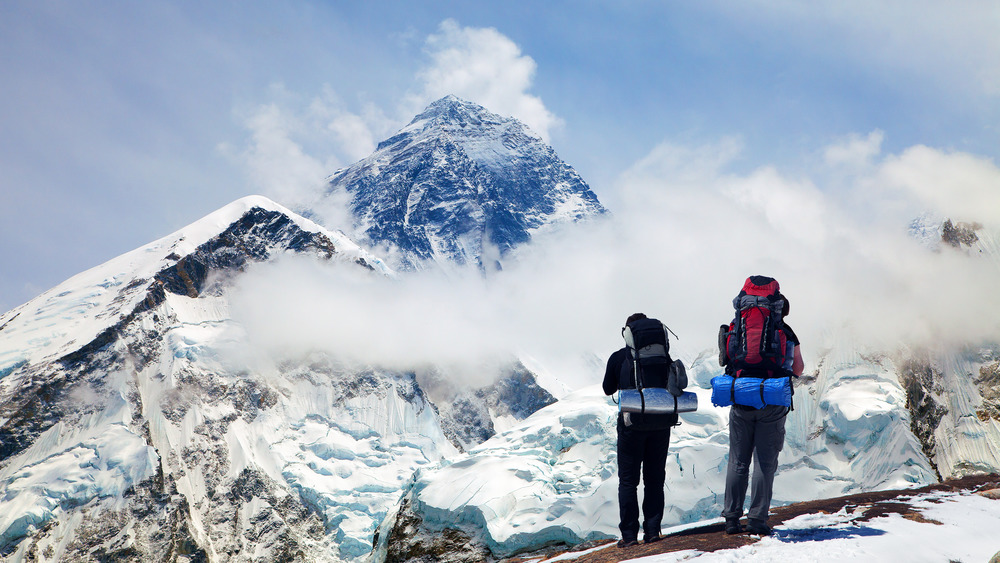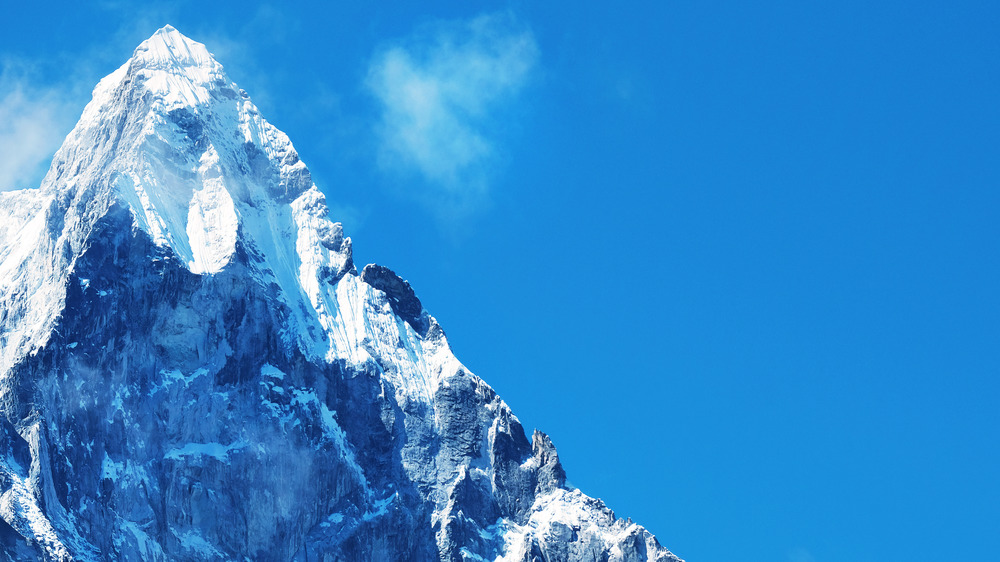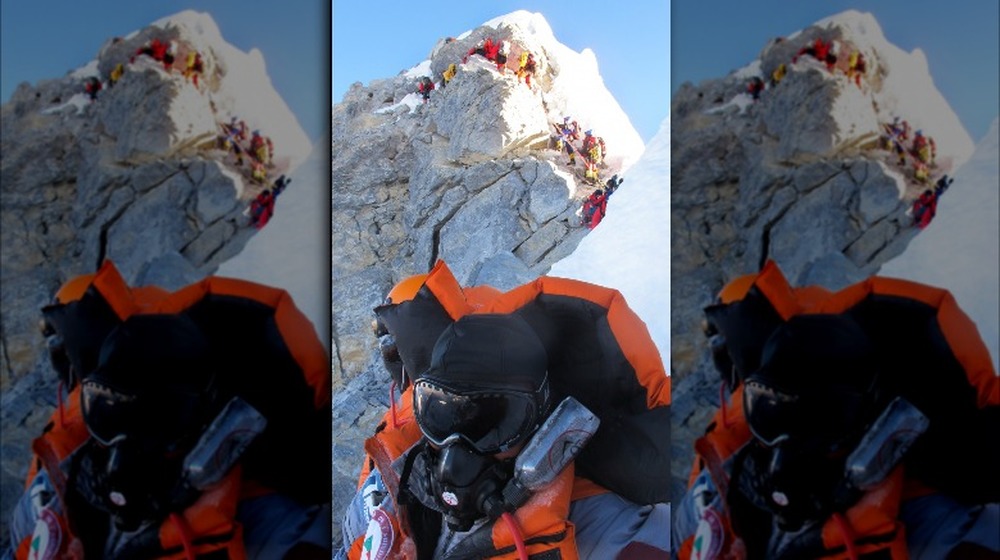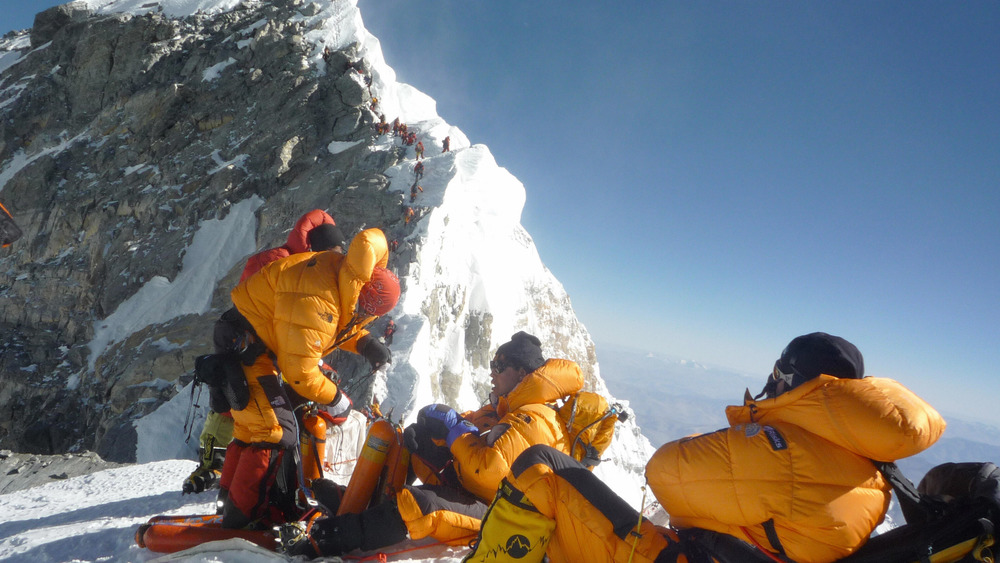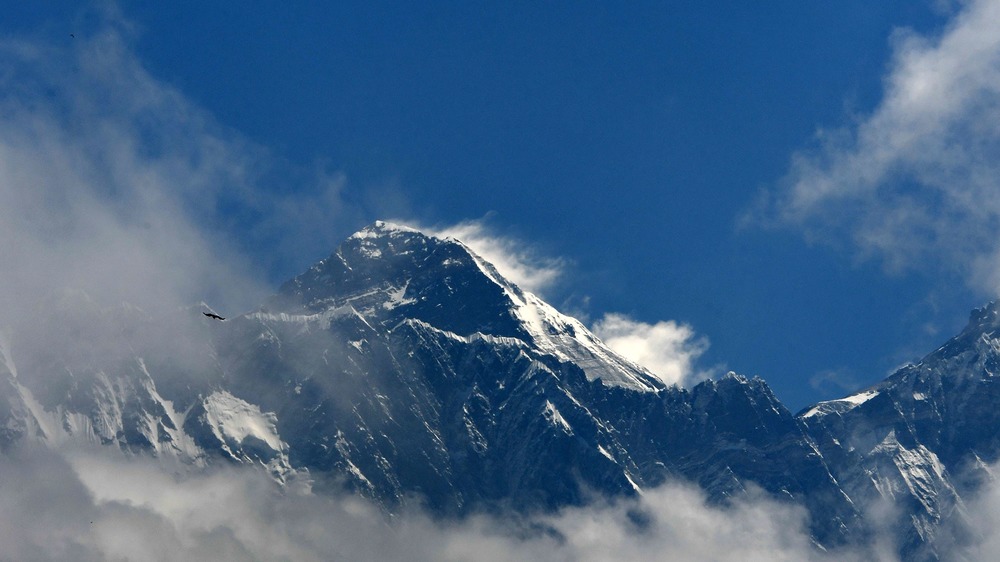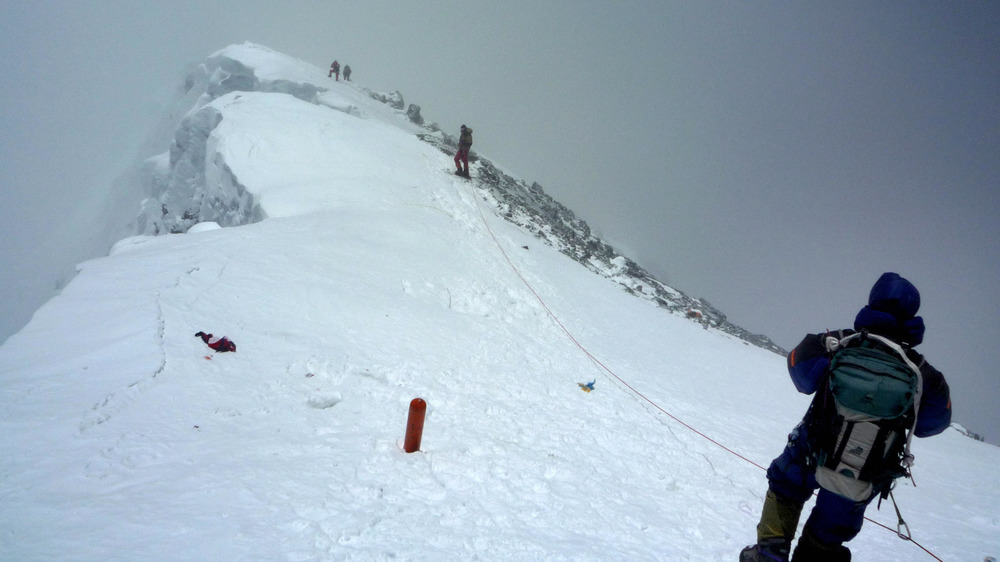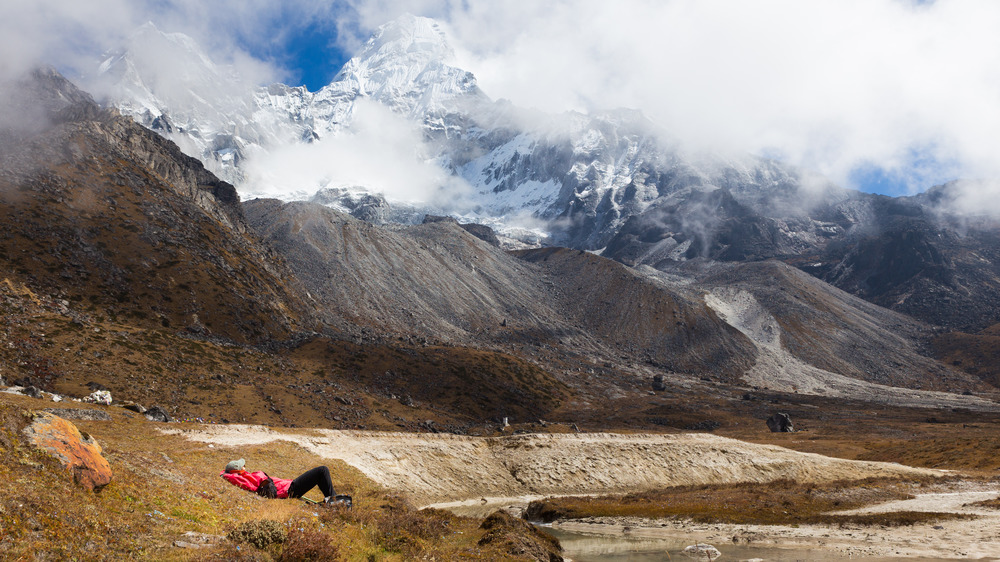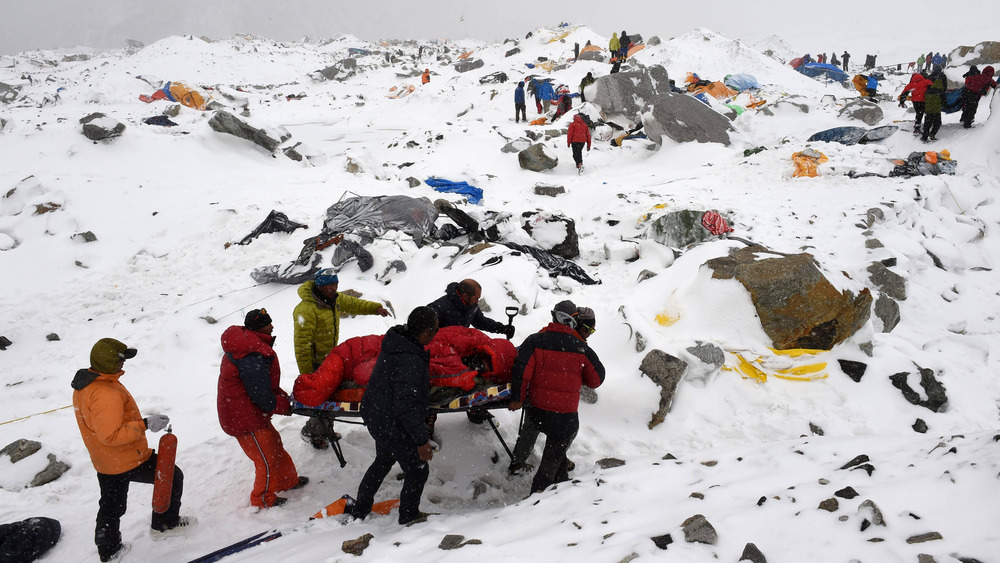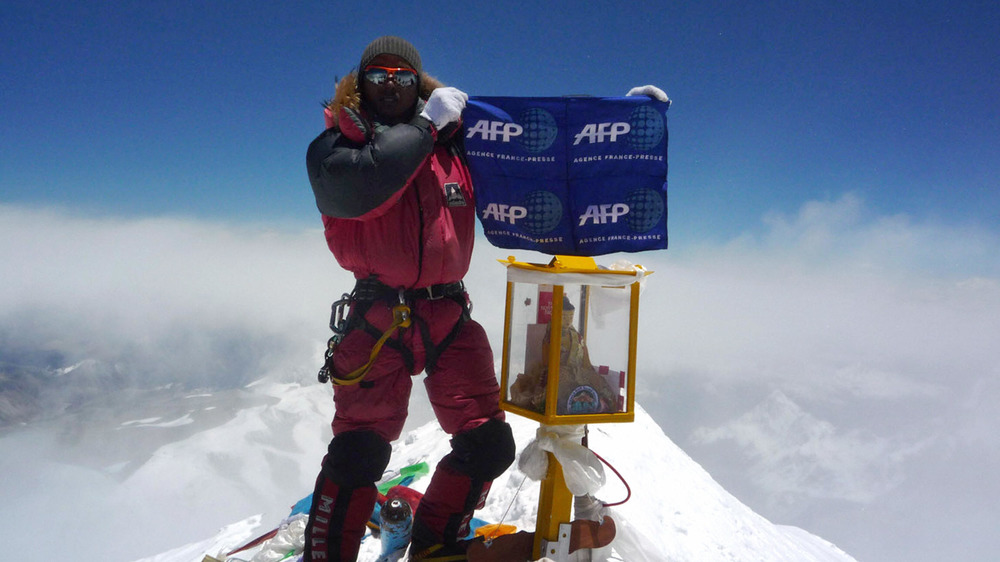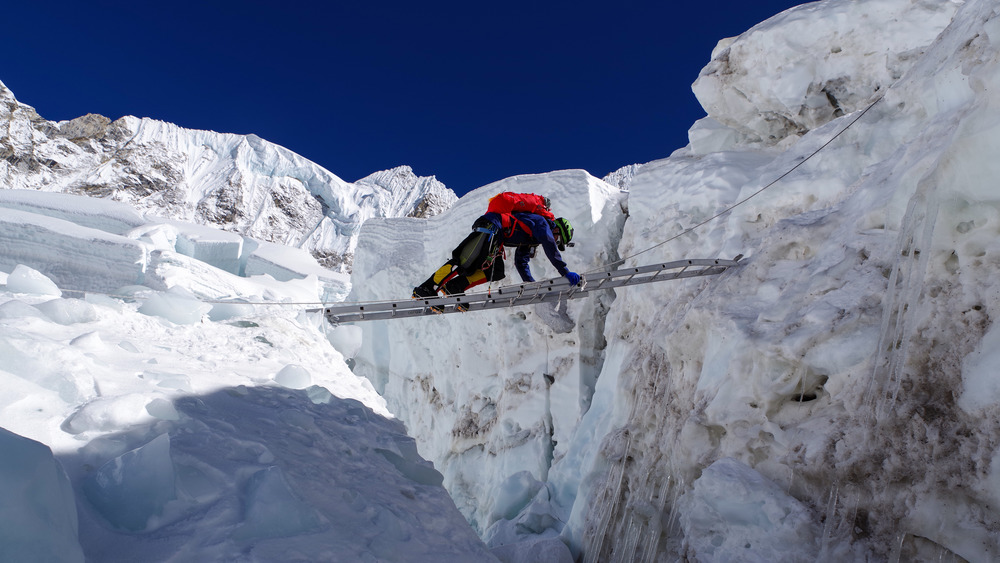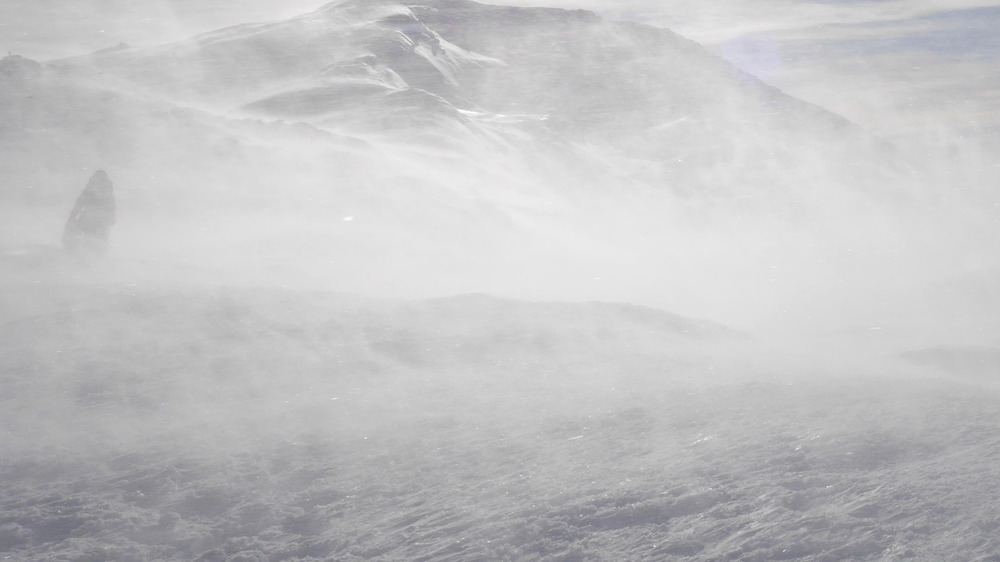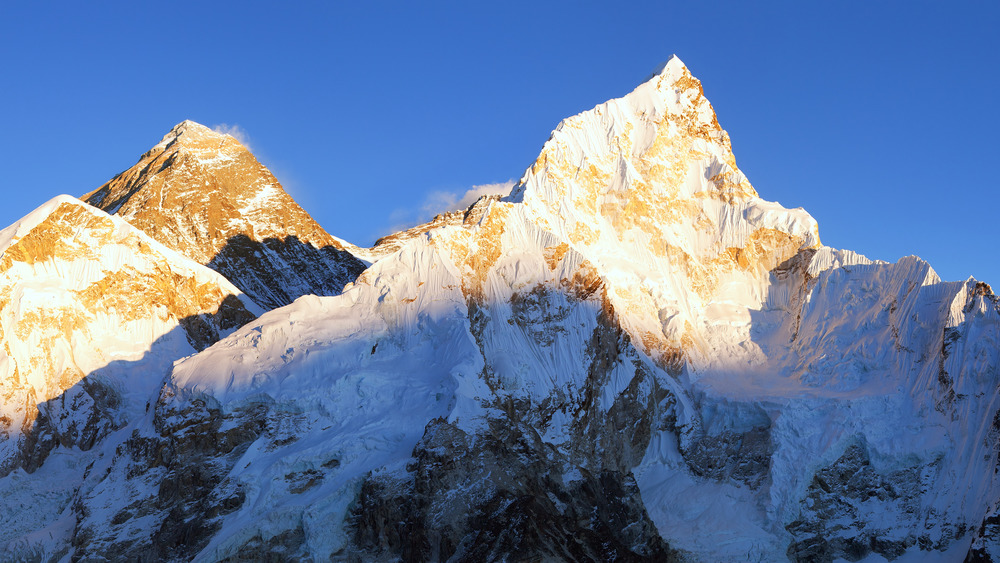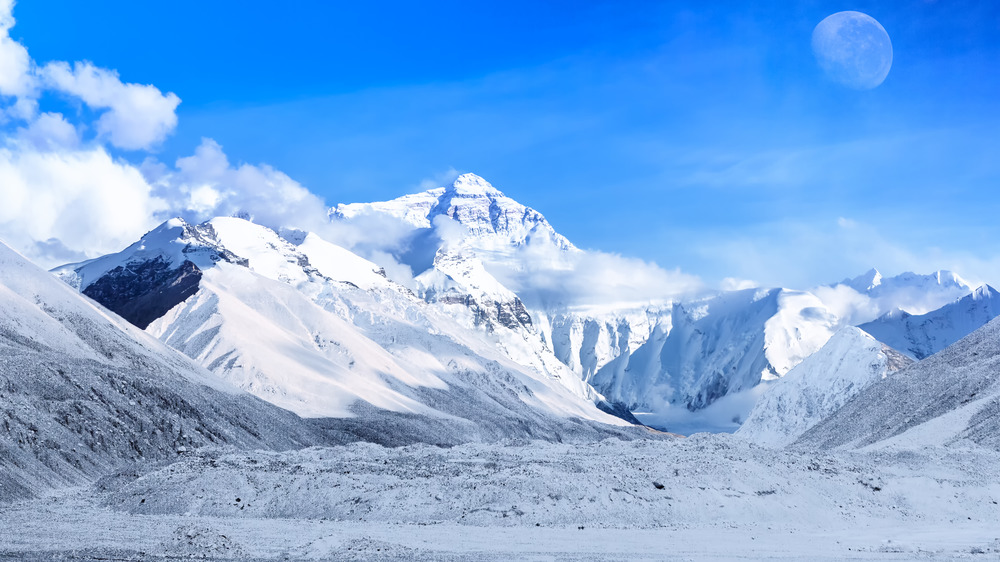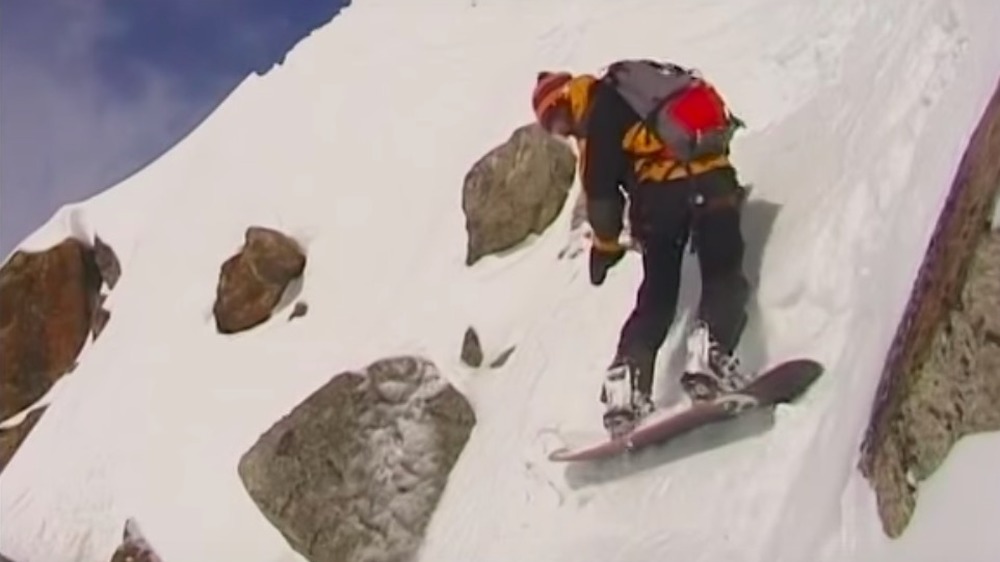Here's Why People Keep Dying On Mount Everest
It was once the holy grail of mountaineering: Conquering Mount Everest, that lonely mountain top nestled among the stars, where few human beings have dared to go. Today, it's like standing in line to ride the Matterhorn at Disneyland, only you could die.
Climbing to the top is no longer an accomplishment for just peak athletes who train for years before facing the greatest physical challenge of their lives. Now, it's kind of a joke. People who sign up to climb the world's tallest peak do it mostly so they can brag about how they climbed the world's tallest peak. There is no physical fitness requirement, just a financial fitness requirement. And it isn't any less dangerous than it was back in 1953, when Edmund Hillary and Tenzing Norgay became the first confirmed climbers to reach the summit. (We don't know if two other climbers who vanished while trying to reach the summit in 1924 actually made it or not).
Climbing Mount Everest is so dangerous that one stretch on the north side is called "rainbow ridge," not because it's all cheerful and unicorn-y but because all the dead bodies are wearing brightly colored climbing gear. And yet people still climb the stupid mountain, because no one ever thinks it will happen to them.
So why so many bodies? Everest climbers have varied causes of death, but here are the most common and why there's a spike recently.
It isn't just falling
Mount Everest is more than 29,000 feet tall. Knowing that, you might be tempted to believe that the major cause of death on the mountain is falling, but alas, that's only the second most common cause of death. According to the BBC, most people who die on Everest are killed in avalanches. The third most common cause of death on the mountain is exposure or frostbite, which accounts for around 11% of fatalities, followed closely by "acute mountain sickness." Around 27% of Everest fatalities are listed as "other," which could include things like falling ice, rope accidents, pneumonia, or even drowning.
Also a bit counterintuitive — more people die on the way down from the summit than on the way up. But "route preparation" is dangerous, too. A total of 120 people have died while working on the routes, with a handful more dying at base camp, en route to base camp, or during an evacuation. So really, the moral of this story is: You're not safe anywhere on Mount Everest.
Traffic jams
Mount Everest is one of the most remote places on Earth. Depending how you measure it, it's the world's tallest peak. It's also one of the world's greatest physical challenges — it takes 10 days just to get to base camp in Nepal, six weeks to acclimatize, and another nine days to climb to the top. It's also expensive — the bottom dollar figure for a Mount Everest expedition is about $30,000, with an average cost of around $65,000. And yet one of the things that's been killing people on Mount Everest is something most of us wouldn't expect: traffic.
No, they didn't build roads to the top of Mount Everest and people are not getting flattened by distracted Honda Prius drivers. According to NPR, the traffic that's killing people is foot traffic. Modern Everest is a tourist trap, and on the perfect climbing day you might encounter hundreds of other climbers, all of whom are trying to get to the exact same spot. So you have to wait in line. Yes, much like your favorite theme park, Everest has a queue. The difference is, if you stand too long in line at a theme park the only pain and suffering you'll experience is the endless whining of your children. If you wait too long in line at Mount Everest, you might run out of oxygen and die. So bring lots of oxygen canisters! Or, you know, just go to your favorite theme park instead.
Inexperienced rich people
You can climb Everest from two different base camps: One is located in Nepal, and the other is in Tibet and operated by the Chinese. China and Nepal used to be pretty selective about who got to go up the mountain. In fact the Telegraph says that up until 1985, Nepal allowed only one expedition on each route at a time. But Nepal is not a wealthy nation, and a single climbing permit costs $11,000. That represents a significant income for Nepal — in total, the climbing industry is worth about $300 million a year. The Nepalese government issued 381 permits in 2019 (a record number), and had no intention of scaling back that year despite the highest death toll since 2015.
And the problem isn't just the number of permits Nepal is issuing, it's who they're issuing those permits to. There are no officially designated physical requirements and no tests you need to pass in order to qualify, so some of the adventure outfits operating in Nepal are less-than-selective about who they'll take to the summit. These are cost-cutting operations, the sort of companies you might turn to if it's always been your dream to climb Mount Everest but you're only sort of wealthy or you're not in especially good shape.
That means more inexperienced climbers on the mountain, which means more danger for everyone. Critics also say that Nepal has a reputation for corruption and lax safety regulations, so that's not helping either.
A tiny, tiny, window of opportunity
You might imagine the best time to visit Everest would be high summer, when you don't have to worry about blizzards and freezing temperatures. But nooooo. You can only really climb Everest during the month of May because there's a very short window of time between the winter storm season and the summer monsoon season.
But hey, that's at least balmy spring, right? Nope. At base camp, daytime temperatures max out at around 59 degrees Fahrenheit, and at night they drop to freezing. That temperature drops roughly 2.7 degrees for every 490 feet of elevation, and the summit is 11,429 feet above base camp. (On the flipside, some parts of Everest can be hot in May, up to 90 degrees, especially broad, snowy expanses that reflect the sun.)
So even in "ideal" conditions the weather is going to suck. And just because you book your ascent during that narrow window doesn't necessarily mean you're going to be safe because in recent years there has been a rash of what NPR called "blue sky" deaths on the summit of Mount Everest. Why? Because everyone wants to climb Everest when the sky is blue, and in the 2019 season the weather window was especially narrow.
Once you reach 25,000 feet, you're already dying
No matter how hard you train or how physically fit you are, once you reach a certain elevation, you're dying, and you still have more than 4,000 feet to go. At that point, you're racing against your own mortality. "Once you get to about 25,000 feet, your body just can't metabolize the oxygen," Outside magazine editor Grayson Schaffer told NPR. "Your muscles start to break down. You start to have fluid that builds up around your lungs and your brain. Your brain starts to swell. You start to lose cognition."
That last 4,000 feet, in fact, is called "the death zone," because it's where a lot of climbers lose their lives. Climbers can suffer from heart attack, stroke, and altitude sickness. Fluid can accumulate in the lungs, leading to altitude pulmonary edema, which causes a cough that's sometimes so severe it can crack a rib. The low oxygen can also lead to transient blindness or hemorrhage in the blood vessels of the eyes. And the whole experience is so physically taxing that one study found Everest climbers typically lose between 10 and 20 pounds. So if you're not a triathlete, stay off Everest. Except oops, even triathletes die there so maybe just stay off Everest no matter who you are.
While you're losing it physically, you're also losing it mentally
Okay, so once you reach the death zone, your body starts to fall apart. But if you can keep your wits about you, you should be able to rationalize the last few thousand feet of the journey, and make smart life or death decisions as they arise. Well, wouldn't it be nice if that were true.
Actually, as your body fails, so does your brain. Climbers can experience high-altitude cerebral edema, which can cause vomiting and also impaired judgement. According to Business Insider, climbers might actually forget they're on Everest, and they'll hallucinate and do other weird, irrational things.
Some climbers may even experience a kind of psychosis in isolation, that is, without any other symptoms of hypoxia. Some climbers have even reported spending hours with companions who turned out to be hallucinations. And when your brain is that kind of messing with you, there's no way you can be trusted to make life or death decisions. Is that theme park starting to sound good yet?
When you can barely help yourself, there's no way you can help others
Just to recap, when you reach the death zone you're physically and mentally messed up. Hopefully, you're not so messed up that you can't finish the climb, and hopefully, you can get to the top and back down again before you become super extra-ultra messed up.
So that's okay, but everyone around you is also very much in the same situation as you, and some people do deteriorate to that state of super extra-ultra messed up. That leaves everyone on Everest with a difficult dilemma. Should you help someone who clearly won't survive without assistance, and in doing so jeopardize your own life? Or should you keep going, reach the summit, and hopefully live to brag about it? Because that's often what it comes down to: Help yourself and survive, or help others and maybe die along with them.
Once you're in the death zone there's actually very little you can do to help a fellow climber in distress because you simply don't have the physical capacity to care for yourself and another person. It's not callousness that abandons people to die on Everest, it's just that abandoning people to die is often the only alternative.
Summit fever can kill you and others
It doesn't take a mountaineer to understand that impaired judgment and high altitudes are not a great combination. But add ego and a sticker price that's comparable to a brand new luxury SUV, and you've got all the ingredients for death and despair.
There is a phenomenon called "summit fever" that exerts frighteningly fierce control over many Everest climbers. It is partially caused by impaired judgment, but it also has to do with fear of failure and "I just dropped $65,000 on this trip and I'll be darned if I'm not going all the way to the top" syndrome. People who have spent years preparing for Everest (or weeks bragging to their friends about how they're going to the summit even though they can't be bothered to go to the gym) may not be ready to face defeat even when it's obvious to everyone around them that they're not going to make it. People on Everest sometimes put the summit ahead of everything, including their own lives and of the lives of others.
According to Business Insider, people who have summit fever are so wrapped up in the quest to reach the top of the mountain that it becomes a part of their identity. That means they stop considering alternatives that don't align with that goal — alternatives like turning around when they run out of oxygen, or abandoning their push for the summit because they're just not physically capable of getting there.
Earthquakes, avalanches and good old fashioned falling to your death
Avalanches are terrifyingly common on Everest — they're the top cause of death for climbers, and they can be triggered by human activity or by earthquakes. According to Bloomberg, in 2015 an earthquake triggered an avalanche that reached base camp and killed 19 people, injuring 60 others.
Falls are common, too, even for experienced climbers. In 2012 a Sherpa died after failing to clip his safety harness to one of the aluminum ladders that bridge large gaps in the ice. In 2016 another Sherpa fell to his death while working on a route 500 feet below the summit. In 2017, Indian climber Ravi Kumar made it to the summit only to die after a 650-foot fall into a crevasse. So that's just a gentle reminder — no matter how skilled you are, no matter how far you've come, Everest might still get the last word.
Green Boots may have been a victim of summit fever
The most famous body on Mount Everest is called Green Boots — most people believe Green Boots was once a climber named Tsewang Paljor, although no positive identification was ever made. Green Boots got his nickname from the brightly colored pair of hiking boots he was wearing, which climbers had to step over on their way to the summit. For a long time, Green Boots served as an elevation marker, helping climbers know how far into the death zone they were and how much further they would have to go.
In 2014, someone moved Green Boots. It's still a mystery as to who did it and why, although it seems likely that the good Samaritan thought the guy should finally rest in peace rather than spending eternity as a landmark.
Green Boots, if he is indeed Tsewang Paljor, is an example of someone who may have a succumbed to summit fever — according to the Epoch Times, Paljor pressed on to the summit despite being warned against it by his deputy team leader, who predicted bad weather. Paljor and his companion made it to the summit, but a blizzard struck during their descent and they never made it back to camp.
David Sharp froze to death as more than 40 climbers passed him by
The most controversial death on Mount Everest was that of British mountaineer David Sharp, who was in fine physical condition and yet still succumbed to the elements. Sharp froze to death in the same cave as Green Boots, but his death was controversial because as many as 40 different climbers passed by without stopping to help.
The public reacted to Sharp's death with outrage, although many climbers defended the actions of the other people who were on the mountain that day. According to Eight Summits, incapacitated climbers in the death zone basically can't be rescued, and Sharp was already near death from severe frostbite. One of the climbers who received the brunt of the criticism was double amputee Mark Inglis, who was himself suffering from severe frostbite and had to be partially carried down the mountain by his Sherpas — and yet, the public was outraged that he hadn't stopped to help.
Sharp was climbing Everest solo, with insufficient oxygen, no Sherpa companions, and no radio. That didn't make him any less worthy of help, but it does explain why he was dying alone in Green Boots' cave. Still, Sharp's death is seen by many as one of Everest's most shameful moments, an example of how in the death zone it's frequently every climber for himself.
Sergei Arsentiev died when he went back up the mountain after a successful climb
Francys Arsentiev wanted to be the first woman to climb to the summit without the use of supplemental oxygen, which is freaking crazy but whatever. She did actually achieve her goal, but her condition deteriorated rapidly on the way down. At some point during the descent she was separated from her husband, Sergei, who assumed she had gone on ahead of him. When Sergei got to camp, he realized that Francys wasn't there and immediately went back up the mountain with medicine and oxygen.
It is unlikely he ever found her. According to the Guardian, Francys was just four hours from the summit when two climbers found her near death and stopped to help, giving up their own bid for the peak. They were ultimately unable to save her, and they had to leave her to die.
Sergei died, too. His body was found one year after his wife's death — it looked like he'd fallen while trying to come to her aid.
Marco Siffredi died from gigantic cahones
Most people who die on Everest aren't being deliberately reckless. Their behavior has to do with poor judgment, and their poor judgment has to do with the high altitudes and diminished oxygen levels they experience once they're inside the death zone. And then there was Marco Siffredi, who was actually being deliberately and unfathomably reckless. This dude died while snowboarding down Mount Everest because that's what happens when you snowboard down Mount Everest. (Also, it's pronounced "eev-rest.")
Now you kind of have to admire the steel cahones that would compel someone to do this. According to Adventure Sports Network, the guy had actually already snowboarded down Everest, it just wasn't on the particular part of the mountain he'd been hoping to snowboard down because there wasn't enough snow there in May 2001. So he returned the following year in September, again summited the mountain, and off he went — never to be seen or heard from again. Later that day, Sherpas claimed to have seen a man snowboarding down the mountain, but when they investigated they could not find any tracks.
There was a lot of fresh powder the day Siffredi disappeared, so the prevailing theory is that he was killed by an avalanche. His body was never recovered.
